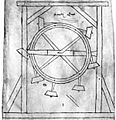Perpetual motion facts for kids
Perpetual motion refers to a movement that goes on forever once started without additional energy added. A machine that could be set in motion once would continue to move forever. Such a device or system would be against the law of conservation of energy. This law states that energy cannot be created, or destroyed, but one form of energy can be transformed into a different one.
Perpetual motion machines have interested inventors for a long time, and even though it has been shown that such a machine cannot exist, people still try to build them.
Perpetual motion machines have been classified into different types. Each type breaks a different law of thermodynamics:
- A perpetual motion machine of the first kind produces energy from nothing. It gives its user unlimited free energy. It violates the law of the conservation of energy.
- A perpetual motion machine of the second kind spontaneously converts thermal energy into mechanical work. In itself, this does not violate the law of the conservation of energy, because there is the same amount of mechanical work than there was of thermal energy. Such machines violate the Second law of thermodynamics. Real heat engines, such as those found in cars, also convert heat energy to work. Such engines have two reservoirs: the heat is transferred from the hot one to the cold one. Some of the heat is converted into mechanical work, the rest is used to heat the cold reservoir. Perpetual motion machines only have one reservoir for the heat. For this reason, they can convert all the heat into mechanical work.
- A perpetual motion machine of the third kind is one that can eliminate effects like friction and other effects that use energy. Because of the inertia of the mass, it can therefore maintain motion forever. This violates the third law of thermodynamics. Although it is impossible to make such a machine, because the loss of energy cannot be completely eliminated in a mechanical system, it is still possible to reduce the loss a great deal. Even if such a machine could be built, it could only be used to store energy forever, and not to produce energy. A frictionless flywheel, for example, would eventually slow down and stop if its kinetic energy were tapped for useful work, and we would get no more energy out than the amount that was initially put in to spin up the flywheel.
Images for kids
-
Perpetuum Mobile of Villard de Honnecourt (about 1230).
-
Perpetual motion wheels from a drawing by Leonardo da Vinci
See also
 In Spanish: Móvil perpetuo para niños
In Spanish: Móvil perpetuo para niños






